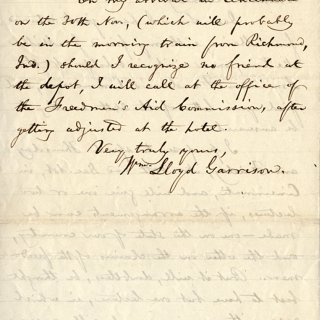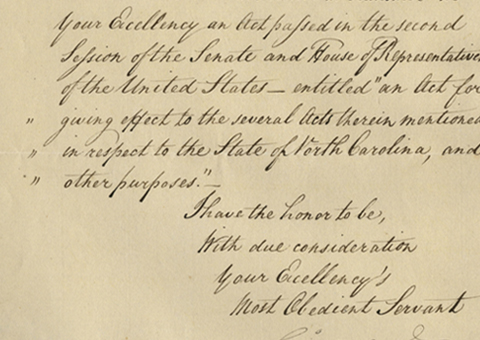Garrison Will Speak on the Claims the Freedmen Have on the Nation



Event at the Western Freedmen’s Aid Commission.
Garrison, one of the nation’s foremost abolitionists, published the aggressively anti-slavery newspaper, The Liberator. After the Civil War, he fought for the rights of the freedmen. J. Miller McKim, a long time comrade of Garrison and a member of the Pennsylvania Antislavery Society, was a friend of Harriet Tubman who helped...
Garrison, one of the nation’s foremost abolitionists, published the aggressively anti-slavery newspaper, The Liberator. After the Civil War, he fought for the rights of the freedmen. J. Miller McKim, a long time comrade of Garrison and a member of the Pennsylvania Antislavery Society, was a friend of Harriet Tubman who helped finance her activities and was also involved in spiriting her out of harm’s way.
Autograph Letter Signed, two pages, Boston, October 29, 1865, to Thomas Kennedy, Secretary of the Western Freedmen’s Aid Commission in Cincinnati. “I have just returned from Maine with my friend J. Miller McKim, on a visit in behalf of the American Freedmen's Commission, and find your letter of the 24th waiting to be answered. I propose to spend Thursday and Friday, Nov. 30th and Dec. 1st, in Cincinnati, and will give one or two lectures, if the arrangements can be made – one on the state of our country and the other on the claims of the freedmen. But it will, doubtless, be thought best to have but one lecture, in which case either evening named will answer my purpose. Mr. McKim tells me he has written to you on the subject, and will arrange matters with you; so, I shall be guided by what you write to him. It will not be necessary, therefore, for you to write to me. On my arrival in Cincinnati on the 30th Nov. (which will probably be in the morning train from Richmond, Ind.), should I recognize no friend at the depot, I will call at the office of the Freedmen's Aid Commission, after getting adjusted at the hotel.”
An interesting letter showing that Garrison’s work for blacks did not cease with their freedom.

Frame, Display, Preserve
Each frame is custom constructed, using only proper museum archival materials. This includes:The finest frames, tailored to match the document you have chosen. These can period style, antiqued, gilded, wood, etc. Fabric mats, including silk and satin, as well as museum mat board with hand painted bevels. Attachment of the document to the matting to ensure its protection. This "hinging" is done according to archival standards. Protective "glass," or Tru Vue Optium Acrylic glazing, which is shatter resistant, 99% UV protective, and anti-reflective. You benefit from our decades of experience in designing and creating beautiful, compelling, and protective framed historical documents.
Learn more about our Framing Services









































































































